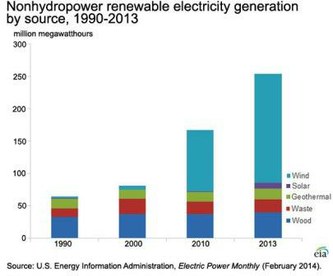
In 2013, 13 percent of the U.S. electricity generated was from renewable sources. Below is a glance at the renewables making up this amount that was published in a news release from the Penn State Extension.
In 2013, the United States used 39 percent coal, 27 percent natural gas, 19 percent nuclear, 1 percent petroleum and 13 percent renewable resources to generate 1.6 billion megawatt hours of electricity.
Of the 13 percent renewable resources, the majority share of generated electricity was from hydropower at 52 percent. Other renewable resources and their share of electric generation are:
- Hydropower, 52 percent
- Wind, 32 percent
- Biomass Wood, 8 percent
- Biomass Waste, 4 percent
- Geothermal, 3 percent
- Solar, 2 percent
According to the Extension, the availability of renewable resources can vary. For Hydroelectric, fluctuations in rain and melt-waters where hydroelectric dams are located can make a difference. Most of the dams, the Extension reported, were built prior to 1980 and are mainly federally operated.
The Extension also noted that wind and solar generation will vary, as well, due to daily and seasonal pattern changes. It was reported that electric generation from wind provided 168,000 megawatts in 2013. “Improved technologies, reduced cost of electricity production from wind, and government incentives helped greatly in boosting the windmill energy.”
Lumber and paper mills, according to the Extension, use their own wood waste to provide much of their own steam and electricity needs. “Biomass waste is mainly municipal solid waste that is used in waste-to-energy power plants,” the Extension reported.
“Although there are some large solar power facilities, solar generated a significant amount of electric generation on small scale installations, such as on private home roofs.”
Although the United States is second to China in renewable electricity generation, the Extension indicated that renewables are not used as much due to the higher cost of building and operating a plant in terms of dollar per unit of electricity output as compared to natural gas or coal–fired plants.
“Renewable resources are often geographically remote, thus building transmission lines to bring the energy to more populated areas where it is needed is expensive,” reported the Extension. “The government has provided tax credits to increase the use of wind and other renewable energy sources.
“Many states have Renewable Portfolio Standards that require a specific portion of the electric generation come from renewable sources. Another option for states is to provide Renewable Energy credits that allow electricity providers to sell renewable energy credits.”